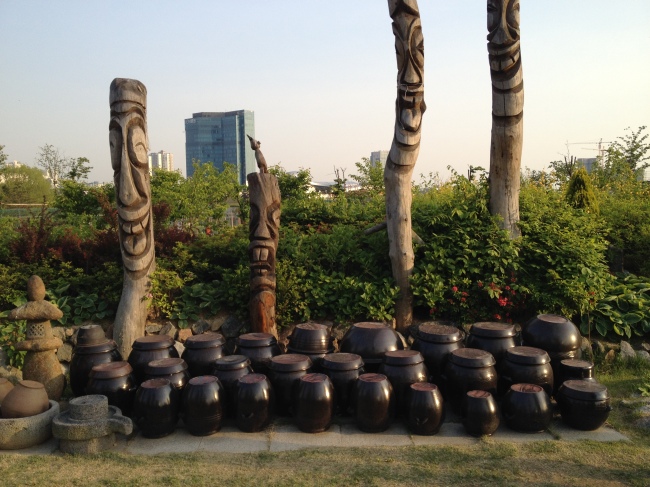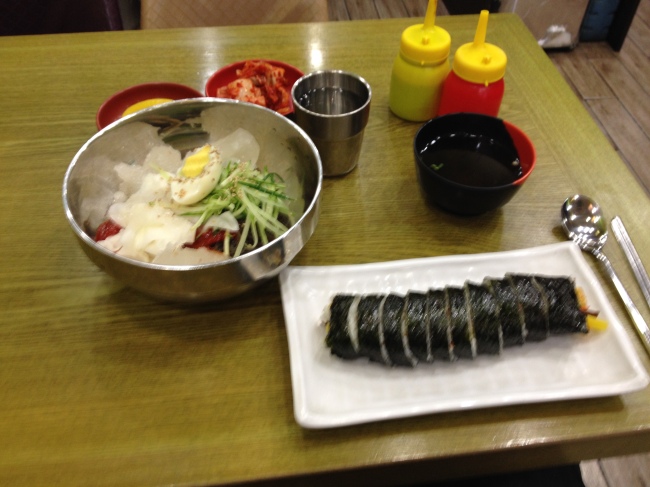When I started putting stuff together to blog about Korea, the topic of food was a popular request. My sister (have you bought her album yet because you really should) and a nerdy friend of mine both put in requests. So, here’s the tl:dr on Korean food:
It’s really good you guys seriously wow.
Now, this should probably come with a nice fat corollary of ‘if you like strong flavours, can at least tolerate spice and aren’t repulsed by the mere thought of seafood’. If that’s all okay with you, then yes, Korea food is fantastic. If you’re unable to eat fish or anything spicier than a korma, you’ll be able to get by but a lot of options won’t be open to you. I love Korean food – when I went to Japan in 2013, I found myself struck by how bland the food was by comparison and seeking out stronger flavours.
Matt asked me how easy it would be to live in Korea as a vegetarian. The answer would be easier than China, but probably not as easy as in the West. Going out for dinner in Korea is generally some form of meat-based main with vegetables on the side – maybe Korean barbeque or a Western-style steakhouse. Fried chicken is a popular snack and people often have it when they go out drinking, as a side. Noodles are commonly served in a chicken or beef-stock broth, so you’d be best going for noodles without broth. There are no shortage of vegetarian dishes to enjoy; thanks to the influence of Buddhism in the country, there is even temple cuisine you could enjoy as part of a trip. Just be careful when ordering kimbap (rice rolls) because there’s commonly a bit of ham in there.
Embed from Getty ImagesYou’d probably have an easier time overall going pescetarian for the duration of your stay, depending on the region you’re in. Fermented fish paste (it’s better than it sounds) is commonly served as a side dish to dip or is used as an ingredient in kimchi in some areas. And finally, it’s probably going to be hard to go vegan in Korea because they love to put eggs in things. Egg cakes are a common side dish and are often in kimbap. If you order noodles, it typically comes with a boiled egg in there. If you order a rice dish, it probably comes with fried egg. Avoiding dairy is a bit easier, though.
Now that those questions are done, let’s talk about the most famous Korean food: kimchi. In case you don’t know, kimchi is typically spiced, fermented cabbage. Which sounds weird, I know, but Koreans really dig the stuff; it’s their national dish and during the Korean War easy access to kimchi was considered so vital to South Korean morale that American support was requested to keep supplies open. They’ve even sent it to space. And it grows on you; the strong, sour and spicy flavour may put you off at first but it pairs so well with rice that you’ll come to crave the stuff.

Kimchi pots are used to store fermenting kimchi for months at a time.
If one kind of kimchi puts you off, it’s worth looking around for another. There are lots of varieties, with different ingredients. Some are made with cucumber, scallions or radish. They will have different levels of sourness, saltiness and spice. Baek kimchi (white kimchi) is prepared entirely without chilli, usually for elderly people or children who have low tolerance for spice. My personal favourite is bokkeum kimchi, which has been stir-fried to give it a milder flavour and softer texture. And unless you’re ordering something with kimchi as a major ingredient, like kimchi jigae (stew), it’s really just an optional side dish.
If you had to ask me what my favourite Korean food was naengmyeon (cold noodles). Korean summers are stupidly hot and so people eat cold noodles – literally served with ice in the bowl – to cool off. Some people say that in hot weather you should eat and drink hot things to cool off. Those people are not in fact human, but devils in human form. If you see one, you are morally obligated to cast them back into the Pit from whence they came and – okay, getting a little off-topic.
Naengmyeon apparently originated in Pyongyang – one variety of the noodles is Pyongyang naengmyeon. But more commonly in the South you’ll find either mul naengmyeon or bibim naengmyeon. Mul naengmyeon is served in a broth and bibim is served without and usually has a chilli sauce instead. Both usually have slices of cucumber, carrot or Korean pear. The long noodles are said to symbolize long life and should be eaten whole, but servers in restaurants often cut the noodles with scissors for ease of eating.
I should probably talk about eating dog in Korea, since it’s something I know has become a cliche about Korean food. It’s not unique to Korea and criticism from the West has made it less common. I’ve never seen anywhere that serves it nor has any Korean I’ve ever spoken to admitted to eating dog. Pet ownership is a fairly new social practice in Korea, but it is growing and they actually have a breed of dog (Nureongi) that was raised more like cattle and not as pets. These dogs are not described with the same word as pet breeds, gyeon, instead called gu (more like ‘mutt). People still do eat dog – there are estimated to be around 600 restaurants in Seoul that illegally serve dog – but it’s generally the older generations, who mostly eat dog-based soups in the summer, and for health reasons.
There is also a pro-dog cuisine movement, but it has come under a lot of fire for cruel methods of slaughtering the animals to tenderize the meat. Technically, South Korean Food Sanitary Law does not list dog as a legal ingredient and restaurants serving dog do so at the risk of their licenses.
Final point: what would you like to read about next? Are there any topics you want to see covered? Leave a comment or tweet your suggestions, feedback and questions.



